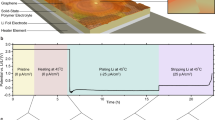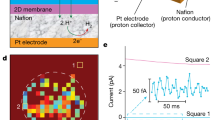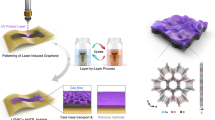Abstract
The performance of new materials and devices often depends on processes taking place at the interface between an active solid element and the environment (such as air, water or other fluids). Understanding and controlling such interfacial processes require surface-specific spectroscopic information acquired under real-world operating conditions, which can be challenging because standard approaches such as X-ray photoelectron spectroscopy generally require high-vacuum conditions. The state-of-the-art approach to this problem relies on unique and expensive apparatus including electron analysers coupled with sophisticated differentially pumped lenses. Here, we develop a simple environmental cell with graphene oxide windows that are transparent to low-energy electrons (down to 400 eV), and demonstrate the feasibility of X-ray photoelectron spectroscopy measurements on model samples such as gold nanoparticles and aqueous salt solution placed on the back side of a window. These proof-of-principle results show the potential of using graphene oxide, graphene and other emerging ultrathin membrane windows for the fabrication of low-cost, single-use environmental cells compatible with commercial X-ray and Auger microprobes as well as scanning or transmission electron microscopes.
This is a preview of subscription content, access via your institution
Access options
Subscribe to this journal
Receive 12 print issues and online access
$259.00 per year
only $21.58 per issue
Buy this article
- Purchase on Springer Link
- Instant access to full article PDF
Prices may be subject to local taxes which are calculated during checkout






Similar content being viewed by others
References
Bluhm, H. et al. In situ X-ray photoelectron spectroscopy studies of gas–solid interfaces at near-ambient conditions. MRS Bull. 32, 1022–1030 (2007).
Somorjai, G. A. & Park, J. Y. Molecular surface chemistry by metal single crystals and nanoparticles from vacuum to high pressure. Chem. Soc. Rev. 37, 2155–2162 (2008).
Parsons, D. F. Structure of wet specimens in electron microscopy. Science 186, 407–414 (1974).
Boyes, E. D. & Gai, P. L. Environmental high resolution electron microscopy and applications to chemical science. Ultramicroscopy 67, 219–232 (1997).
Sharma, R. & Weiss, K. Development of a TEM to study in situ structural and chemical changes at an atomic level during gas–solid interactions at elevated temperatures. Microsc. Res. Tech. 42, 270–280 (1998).
Marton, L. La microscopie electronique des objects biologiques. Bull. de L'Acad. Royale de Belgique 21, 553–560 (1935).
Abrams, I. & McBain, J. A closed cell for electron microscopy. J. Appl. Phys. 15, 607–609 (1944).
Swift, J. & Brown, A. An environmental cell for the examination of wet biological specimens at atmospheric pressure by transmission scanning electron microscopy. J. Phys. E 3, 924–926 (1970).
Kohyama, N., Fukushima, K. & Fukami, A. Observation of hydrated form of tubular halloysite by an electron microscope equipped with an environmental cell. Clays Clay Miner. 26, 25–40 (1978).
Daulton, T. L., Little, B. J., Lowe, K. & Jones-Meehan, J. In situ environmental cell transmission electron microscopy study of microbial reduction of chromium(VI) using electron energy loss spectroscopy. Microsc. Microanal. 7, 470–485 (2001).
Gai, P. L. & Calvino, J. J. Electron microscopy in the catalysis of alkane oxidation, environmental control, and alternative energy sources. Ann. Rev. Mater. Res. 35, 465–504 (2005).
Thiberge, S., Zik, O. & Moses, E. An apparatus for imaging liquids, cells, and other wet samples in the scanning electron microscopy. Rev. Sci. Instrum. 75, 2280–2289 (2004).
de Jonge, N., Peckys, D. B., Kremers, G. J. & Piston, D. W. Electron microscopy of whole cells in liquid with nanometer resolution. Proc. Natl Acad. Sci. USA 106, 2159–2164 (2009).
Hitchcock, A. P., Morin, C., Heng, Y. M., Cornelius, R. M. & Brash, J. L. Towards practical soft X-ray spectromicroscopy of biomaterials. J. Biomat. Sci. Polymer Edition 13, 919–937 (2002).
Yoon, T. H. Applications of soft X-ray spectromicroscopy in material and environmental sciences. Appl. Spectrosc. Rev. 44, 91–122 (2009).
Salmeron, M. & Schlogl, R. Ambient pressure photoelectron spectroscopy: a new tool for surface science and nanotechnology. Surf. Sci. Rep. 63, 169–199 (2008).
Winter, B. et al. Full valence band photoemission from liquid water using EUV synchrotron radiation. J. Phys. Chem. A 108, 2625–2632 (2004).
Starr, D. E., Wong, E. K., Worsnop, D. R., Wilson, K. R. & Bluhm, H. A combined droplet train and ambient pressure photoemission spectrometer for the investigation of liquid/vapor interfaces. Phys. Chem. Chem. Phys. 10, 3093–3098 (2008).
Gunther, S. et al. In situ X-ray photoelectron spectroscopy of catalytic ammonia oxidation over a Pt(533) surface. J. Phys. Chem. C 112, 15382–15393 (2008).
Novoselov, K. S. et al. Two-dimensional atomic crystals. Proc. Natl Acad. Sci. USA 102, 10451–10453 (2005).
Pacile, D., Meyer, J. C., Girit, C. O. & Zettl, A. The two-dimensional phase of boron nitride: few-atomic-layer sheets and suspended membranes. Appl. Phys. Lett. 92, 133107 (2008).
Hernandez, Y. et al. High-yield production of graphene by liquid-phase exfoliation of graphite. Nature Nanotech. 3, 563–568 (2008).
Emtsev, K. V. et al. Towards wafer-size graphene layers by atmospheric pressure graphitization of silicon carbide. Nature Mater. 8, 203–207 (2009).
Kim, K. S. et al. Large-scale pattern growth of graphene films for stretchable transparent electrodes. Nature 475, 706–710 (2009).
Stankovich, S. et al. Synthesis of graphene-based nanosheets via chemical reduction of exfoliated graphite oxide. Carbon 45, 1558–1565 (2007).
Meyer, J. C., Girit, C. O., Crommie, M. F. & Zettl, A. Imaging and dynamics of light atoms and molecules on graphene. Nature 454, 319–322 (2008).
Wilson, N. R. et al. Graphene oxide: structural analysis and application as a highly transparent support for electron microscopy. ACS Nano 3, 2547–2556 (2009).
Bunch, J. S. et al. Impermeable atomic membranes from graphene sheets. Nano Lett. 8, 2458–2462 (2008).
Booth, T. J. et al. Macroscopic graphene membranes and their extraordinary stiffness. Nano Lett. 8, 2442–2446 (2008).
Stolyarova, E. et al. Observation of graphene bubbles and effective mass transport under graphene films. Nano Lett. 9, 332–337 (2009).
Dikin, D. A. et al. Preparation and characterization of graphene oxide paper. Nature 448, 457–460 (2007).
Chen, C. M. et al. Self-assembled free-standing graphite oxide membrane. Adv. Mater. 21, 3007–3011 (2009).
Hummers, W. S. & Offeman, R. E. Preparation of graphitic oxide. J. Am. Chem. Soc. 80, 1339 (1958).
Cote, L. J., Kim, F. & Huang, J. X. Langmuir–Blodgett assembly of graphite oxide single layers. J. Am. Chem. Soc. 131, 1043–1049 (2009).
Gregoratti, L. et al. 48-Channel electron detector for photoemission spectroscopy and microscopy. Rev. Sci. Instrum. 75, 64–69 (2004).
Kolmakov, A. et al. Spectromicroscopy for addressing the surface and electron transport properties of individual 1-D nanostructures and their networks. ACS Nano 2, 1993–2000 (2008).
Cumpson, P. J. & Seah, M. P. Elastic scattering corrections in AES and XPS. 2. Estimating attenuation lengths and conditions required for their valid use in overlayer/substrate experiments. Surf. Interface Anal. 25, 430–446 (1997).
Powell, C. J. & Jablonski, A. Surface sensitivity of X-ray photoelectron spectroscopy. Nucl. Instrum. Methods A 601, 54–65 (2009).
Akhavan, O. The effect of heat treatment on formation of graphene thin films from graphene oxide nanosheets. Carbon 48, 509–519 (2010).
Mkhoyan, K. A. et al. Atomic and electronic structure of graphene-oxide. Nano Lett. 9, 1058–1063 (2009).
Cote, L. J., Cruz-Silva, R. & Huang, J. X. Flash reduction and patterning of graphite oxide and its polymer composite. J. Am. Chem. Soc. 131, 11027–11032 (2009).
Yang, D. et al. Chemical analysis of graphene oxide films after heat and chemical treatments by X-ray photoelectron and micro-Raman spectroscopy. Carbon 47, 145–152 (2009).
Xu, K., Cao, P. G. & Heath, J. R. Graphene visualizes the first water adlayers on mica at ambient conditions. Science 329, 1188–1191 (2010).
Aleman, B. et al. Transfer-free batch fabrication of large-area suspended graphene membranes. ACS Nano 4, 4762–4768 (2010).
EMS & GF1200 Graphene Support Films for TEM (Electron Microscopy Supplies, 2010); available via www.emsdiasum.com.
Acknowledgements
A.K. thanks E. Strelcov, C. Watts and J. Bozzola (SIUC) for their help in the preparation of the experiment. The work at ELETTRA was partly supported by AMBIOSEN Friuli Venezia-Giulia regional grant 47/78. M.K.A. thanks P. Parisse for AFM measurements. The TEM and FIB work was performed in the EPIC facility of the NUANCE Center at Northwestern University. The NUANCE Center is supported by NSF-NSEC, NSF-MRSEC, the Keck Foundation, the State of Illinois and Northwestern University. The SIUC part of the research was supported by a NSF ECCS-0925837 grant. L.J.C and J.H. were supported by the NSF through a CAREER award (DMR 0955612).
Author information
Authors and Affiliations
Contributions
A.K. conceived the project, designed and tested the E-cell prototypes, and assembled the manuscript, with contributions from all co-authors. D.D., L.C. and J.H. developed the methods of GO synthesis, processing and Langmuir–Blodgett deposition onto SiO2/Si3N4 membrane samples. D.D. performed all micromachining and carried out SEM, TEM and HRTEM characterization of the GO overlayers and suspended membranes. M.K.A., M.A., L.G., S.G. and M.K conducted the SPEM experiments and the corresponding data analysis of the photoelectron images and spectra. A.K. and S.G. participated in spectromicroscopy tests as users of the ELETTRA ESCA microscopy beamline.
Corresponding author
Ethics declarations
Competing interests
The authors declare no competing financial interests.
Supplementary information
Supplementary information
Supplementary information (PDF 1132 kb)
Rights and permissions
About this article
Cite this article
Kolmakov, A., Dikin, D., Cote, L. et al. Graphene oxide windows for in situ environmental cell photoelectron spectroscopy. Nature Nanotech 6, 651–657 (2011). https://doi.org/10.1038/nnano.2011.130
Received:
Accepted:
Published:
Issue Date:
DOI: https://doi.org/10.1038/nnano.2011.130
This article is cited by
-
Water at charged interfaces
Nature Reviews Chemistry (2021)
-
Spatially Resolved Photoelectron Spectroscopy from Ultra-high Vacuum to Near Ambient Pressure Sample Environments
Topics in Catalysis (2018)
-
From Surfaces to Interfaces: Ambient Pressure XPS and Beyond
Topics in Catalysis (2018)
-
In Situ Electrochemical Cells to Study the Oxygen Evolution Reaction by Near Ambient Pressure X-ray Photoelectron Spectroscopy
Topics in Catalysis (2018)
-
Size contrast of Pt nanoparticles formed on neighboring domains within suspended and supported graphene
Nano Research (2018)



